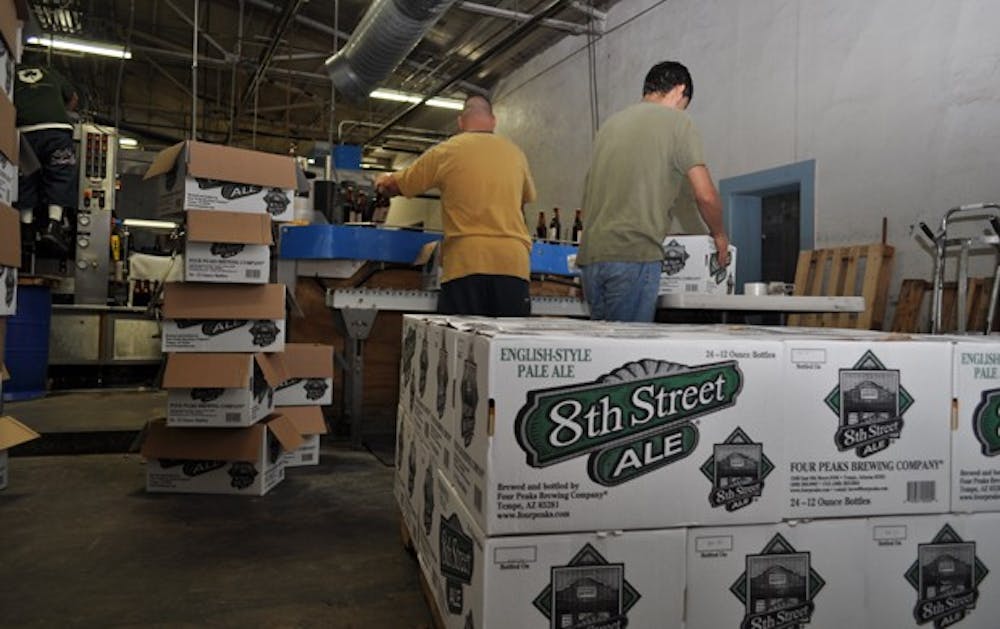
From the pull of a lever this liquid is triggered and forced from its frost-covered steal barrels, it travels through an often-twisted line of tubing to the mouth of a spout, where it bubbles and pops as it’s spit out, meeting the air only briefly before falling into the bottom of an ice-cold glass, foaming up, then settling down. Its loved contents are enjoyed by students, professors and others throughout the world. The common denominator? People love beer.
Beer: a word that comes almost synonymously with the college experience. Yet, ironically enough, when most college students are confronted with words such as IPA, Tripel or Lambic, their brains begin to ache more than the morning after a hard night of drinking.
Coors Light and PBR are about the extent of a student’s beer education. But beer goes far beyond the purpose of getting drunk and playing beer pong. Any beer snob will you tell you, beer is like drinkable art: some brands craft unique blends that stand alone in comparison to anything else.

What is beer?
Making beer (well, good beer) is a complicated process, but to lay it out simply: First, malted barley and water are mixed. A mushy wet substance is produced; it is drained; the drained sugary liquid is called wort. Next, hops are added to the wort; this adds flavor and aroma to the beer. Typically, the hoppier the beer, the more bitter it is to taste. Fun fact: The hop and the cannabis are cousins in the plant family; but, please, don’t try to smoke a hop.
Next yeast is mixed with the hopped wort and left to ferment. Yeast turns the natural sugars of the wort into ethanol and carbon dioxide. Ethanol gets you drunk; carbon dioxide makes bubbles.
The fermentation process turns beer into two basic categories: ales and lagers. When yeast is left to ferment at a higher temperature, the foam produces floats, creating an ale; this includes (but is not limited to) pale ales, stouts, porters, hefeweizens, blondes, IPAs, Belgian ales and Brown ales.
When fermentation is left at a lower temperature, the foam does not rise; thus, lagers are created. This includes (but is not limited to) pilsners, bocks, Doppelbocks and Dunkels.
Many variations of this process can be made to differentiate beer even more, including the types of yeast used, the type of grain used, the amount of hops added, location of where the beer is brewed, and added flavorings such as fruits, herbs and chocolate are only among the few alterations that can be made to produce different styles of beer.
There is a major difference between American, German, English and other countries’ beers. The guide provided focuses on American beer styles; there are plenty more, but explaining all of them would fill a book and students in college barely have time to read their assigned texts as it is.
American Lager: This is the bare, basic beer. It ranges from pilsner color to golden hues. Typically corn or rice syrup is added to beer to achieve low gravity—sugar is highly fermentable, meaning that a higher percentage of sugars ferment into alcohol, leaving behind less flavor.
Popular Brew: Budweiser, Coors Light
Something New: Sleepy Dog Brewery’s “Yellow #1” Light American-styled lager or “Up the River,” an American-style lager from Mudshark brewing in Lake Havasu City.
Pilsner: The world’s first light-style beer. It has a transparent straw color, a hoppy aroma, a light grainy taste, and a refreshing finish.
Popular Brew: Dos Equis
Something new: No local breweries make a pilsner, but if you’re looking for a good craft beer, try “Mama’s little Yella Pils” by Oskar Blues out of Colorado or Odell Brewing’s Double Pilsner, also out of Colorado.
Hefeweizen: A wheat beer—during the brewing process wheat is largely used in place of barley, although most wheat beers are still brewed with a bit of barley. This makes the beer much thicker and almost cloudy looking. There are different types of wheat beers: Bavarian-inspired wheat beers can have almost a banana taste, while Belgian-style hefe’s typically have a tangy, citrusy taste added. With nearly no hop taste at all, this beer goes down smooth, but is heavy. Almost always drank with a lemon wedge or orange.
Popular Brew: Blue Moon
Something New: Sun-Up Brewing “Horizon,” a German-styled wheat beer or Four Peak’s Bavarian-styled Hefeweizen.
Amber/ Red Ale: Unlike the pilsner’s bitterness from hops, and the hefe’s smooth wheat taste. They have a full-bodied taste, and typically a reddish/brown color.
Popular Brew: Fat Tire Amber Ale
Something New: San Tan’s “Epicenter,” an Amber Ale or Sun-Up Brewery’s “Armadillo” Red Ale.
Brown Ale: The brown ales that you will typically find have a variety of nutty and coffee flavors. Inspired from the English brown ale, it is smooth and easy to drink. Often, brown ales have a certain fruity undertone about them.
Popular Brew: Newcastle Brown Ale
Something New: Four Peak’s seasonal “Leroy Brown Ale,” or check out Nimbus’s self titled Brown Ale.

Pale Ale and the India Pale Ale: British inspired, this beer has a good balance of malt and hop flavor. Sometimes a bit bitterer, this beer ranges from having floral undertones, to being very pungent. Now, an IPA is basically a Pale Ale with all of its qualities heightened; more hops are added, boosting this beer’s aroma and flavor.
Popular Brew: Sierra Nevada Pale Ale
Something New: Four Peaks “8th Street Pale Ale” and “Raj IPA.” Also check out Nimbus brewery’s self-titled Pale Ale.
Stout: Inspired from English and Irish stouts, the American stout mirrors the originals. Its defining characteristic is being made with black un-malted barley, giving the stout a distinctive taste. It’s dark, creamy and sometimes accented with coffee, milk, sugar and oatmeal.
Popular Brew: Guinness
Something New: San Tan’s Irish-style Gordo Stout or Sonoran Brewery’s “Inebriator” stout. Beware! It is not for the faint of heart!
Reach the reporter at alsavage@asu.edu




